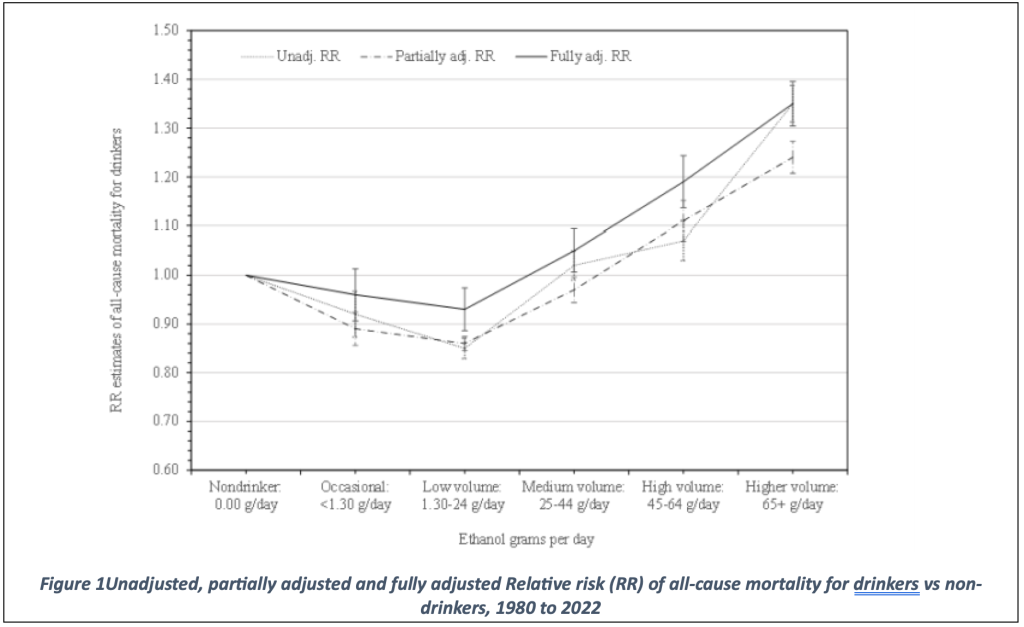Last month, I wrote about the latest attempt by Tim Stockwell and colleagues to erase the health benefits of moderate alcohol consumption (Zhao et al. 2023). There is now an expert review that is worth reading from the International Scientific Forum on Alcohol Research.
The current paper by Zhao J., Stockwell T., Naimi T., Churchill S., Clay J., Sherk A., (2023) is a follow-up paper to two published previously by this group trying to undermine the well-established J-shaped association between moderate alcohol consumption, cardiovascular disease and all-cause mortality. The first paper written by Filmore et al. (Fillmore et al., 2007) re-iterated the old and already falsified hypothesis that the J-curve would be generated by “sick quitters” or badly categorized moderate drinkers. The “sick quitters” hypothesis was duly discredited by reanalysis of the studies (Klatsky and Udaltsova, 2007). Also repeat studies adjusting for the claimed bias still showed a cardioprotective effect for regular light to moderate alcohol consumption (Di Castelnuovo et al., 2006, Ronksley et al., 2011).
The second paper written by Stockwell et al. (2016) was previously critically reviewed by ISFAR. Forum members noted that the authors were very selective in choosing papers to include in their new analyses: they identified 2,575 studies on the subject, analysed 87, but then found some reason to exclude almost all of these studies to reach a conclusion that “ . . . there was no significant protection of all-cause mortality for low-volume drinkers (RR = 1.04, 95% CI [0.95, 1.15]) ” based on what is apparently only six (6!) remaining studies. Their new analysis markedly distorted the accumulated scientific evidence on alcohol and CVD and mortality. As stated by one Forum member, “The biased selection of studies that are included undermines the value of the paper, but more importantly promulgates misinformation in the name of appropriate scientific method. Failure to acknowledge the robust body of knowledge that supports the opposite conclusion, and disqualification of extensive studies that offer plausible biologic explanation of observed benefits, is unconscionable.”
The unadjusted relative risks showed the classical J-shape. Surprisingly, even the fully adjusted relative risk showed a J-shaped curve as well: a significantly reduced relative risk for all-cause mortality for those drinking a ‘low volume’, namely 1.30-24 g/day. The authors, however, state that in their fully adjusted model “daily low or moderate alcohol intake was not significantly associated with all-cause mortality risk” and provide a risk estimate of 0.93 (CI: 0.85-1.01). This discrepancy between figure and text is not addressed by the authors. It is amazing that this discrepancy has not been noted by the reviewers and editors of JAMA Network Open. One wonders if reviewers and editors have read this paper in detail, a first task of reviewers would be to check whether the data support the conclusions. The editors have missed the fact that data and procedures, which were essential to derive at their conclusions have been transferred to the supplemental materials. This makes it impossible to grasp the authors approach from what was written in the original JAMA paper.

The key features that clearly demonstrate bias in the present paper are:
1. This is the third attempt by the same group of researchers to disprove the beneficial relationship between light to moderate alcohol consumption and cardiovascular health. The first attempt (Fillmore et al, in 2006) was discredited by reanalysis of the studies. Reanalysis showed that after adjusting for the claimed bias the cardioprotective effect for regular light to moderate alcohol consumption was still apparent.
2. Numerous meta-analyses have been undertaken over the past 15 years that have adjusted for this proposed bias and they have consistently shown that there is a cardioprotective effect for regular light to moderate alcohol consumption.
3. In this new paper, Zhao et al., (2023) have again biased their meta-analysis by ‘cherry picking’ a small number of studies for their meta-analysis – they discarded 3230 studies and analysed only 107. The 107 studies selected did relate consumption to disease and all-cause mortality but the authors carefully avoided hundreds of validated studies that showed reduced disease risk among light to moderate drinkers.
4. Countless animal and human studies over the past four decades have provided extensive evidence for the biological mechanisms supporting the findings that light to moderate alcohol consumption is cardioprotective. Zhao et al., (2023) seem to have deliberately pretended that they do not exist.

No comments:
Post a Comment
Comments are only moderated after 14 days.